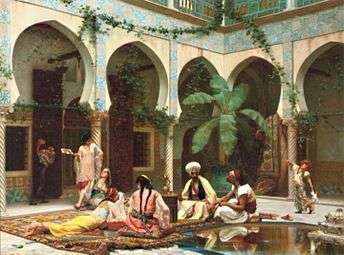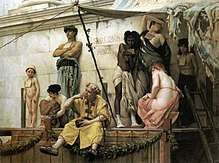Gustave Boulanger
Gustave Clarence Rodolphe Boulanger (25 April 1824 – October 1888) was a French figure painter known for his classical and Orientalist subjects.
Gustave Boulanger | |
|---|---|
.jpg) | |
| Born | Gustave Clarence Rodolphe Boulanger 25 April 1824 |
| Died | October 1888 Paris |
| Nationality | French |
| Education | Pierre-Jules Jollivet; Delaroche; École de Rome |
| Movement | Academic art, Orientalist themes |
| Awards | 25 April 1824 |
Life and career

Boulanger was born at Paris in 1824. He was orphaned at age 14, and his uncle and guardian subsequently sent him to the studio of Pierre-Jules Jollivet and then to Delaroche in 1840. In 1849 took the Prix de Rome with his painting, Ulysses, a work which combined a classical approach with Orientalist overtones.[1]
In 1845, he first visited Algeria and this gave him an interest in Orientalist themes, which was taken up later by his friend Jean-Léon Gérome. Boulanger's knowledge of Pompeii, which he visited while studying at the École de Rome, also gave him ideas for many future pictures. His paintings are prime examples of academic art of the time, particularly history painting. Boulanger had visited Italy, Greece, and North Africa, and his paintings reflect his attention to culturally correct details and skill in rendering the female form.[2] His works include a Moorish Cafe (1848), Cæsar at the Rubicon (1865), the Promenade in the Street of Tombs, Pompeii (1869), and The Slave Market (1888). The recipient of many medals, he became a member of the Institut de France in 1882.[1]
He began teaching at the Institut de France in 1882 and was an influential teacher, noted for his dislike of the Impressionism.
Pupils
Boulanger taught at Académie Julian,[3] among his students were :
- Jules Benoit-Lévy
- Walter Lofthouse Dean
- Arthur Wesley Dow [4]
- Ernst Friedrich von Liphart[5]
- Théophile Poilpot
- Osman Hamdi Bey
- Alexander Ignatius Roche,[6] one of the Glasgow Boys
- Georges Rochegrosse [7]
- Elmer Boyd Smith[8]
- Albert Beck Wenzell,[9]
- Willard Metcalf[10]
- Harry Watrous[11]
Work
- Ulysse et Euryclée, 1849
 Hercules and Omphale, date unknown
Hercules and Omphale, date unknown Après le bain, 1867
Après le bain, 1867 C'est un Emir, 1870
C'est un Emir, 1870 The Slave Market, 1886
The Slave Market, 1886
See also
References
- "Boulanger, Gustave". New International Encyclopaedia. 3. Dodd, Mead and Company. 1906. pp. 861–62. Retrieved 7 July 2011.
- Masler, Marilyn (2009). "Embracing the Academic Tradition". In Masler, Marilyn; Pacini, Marina (eds.). Carl Gutherz: Poetic Vision and Academic Ideals. Jackson, Tennessee: University Press of Mississippi. pp. 38–39. ISBN 978-0-915525-11-9.
- (fr) Gallica . French archives
- Waller, S. (ed.), Foreign Artists and Communities in Modern Paris, 1870-1914: Strangers in Paradise, Routledge, 2017, p. 119
- Ernst Friedrich von Liphart, RusArtnet, retrieved 1 January 2014
- http://www.caltongallery.co.uk/Artist.aspx?id=Artist.ROCHE
- Waller, S. (ed.), Foreign Artists and Communities in Modern Paris, 1870-1914: Strangers in Paradise, Routledge, 2017, p. 119
- "biography of Elmer Boyd SMITH (1860-1943)". artprice. Retrieved Oct 7, 2018.
- http://americanartgallery.org/artist/readmore/id/609
- https://americanart.si.edu/artist/willard-l-metcalf-3295
- Levy, Florence N., editor. American Art Annual, 1903-1904, vol. IV, part II, p. 78.
Sources
This article incorporates text from a publication now in the public domain: Gilman, D. C.; Peck, H. T.; Colby, F. M., eds. (1905). New International Encyclopedia (1st ed.). New York: Dodd, Mead. Missing or empty |title= (help)
| Wikimedia Commons has media related to Gustave Boulanger. |